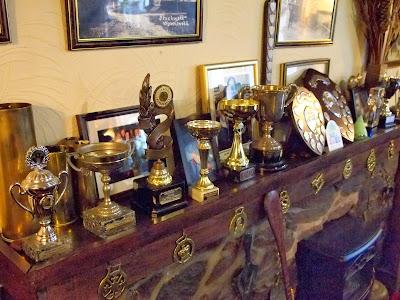The Long Alley at the Three Crowns could be said to represent a triumph of skittling ingenuity over the apparently insurmountable issue of there being no existing alley at the pub! Even more so given that there appears to be nowhere convenient to create one, the tidy Pétanque terrain in the garden being well and truly ruled out.
Skittlers, and those from Wymeswold in particular, are nothing if not tenacious in pursuit of their game though. Confident in the knowledge that all they required was some 30 feet of clear space, ideally free from obstacles such as tables and customers, the skittles team set about creating something from nothing in what is now the well appointed upstairs games room.
An upstairs alley like the one shown here at the Three Crowns is certainly not unique. I've seen a similar, much lengthier and roomier alley at the Old Kings Head in Belper for example. The skittles players at the Three Crowns were certainly up against it though, their ingenuity pushed to the limit due to the fact that the upstairs games room falls short of the full alley length by a few crucial feet. Even this wasn't considered an insurmountable problem though, with players forced to throw from outside the room to achieve the minimum distance required for league play. That's what doorways are for I guess, and it's on the landing at the top of the stairs that you'll find the line on the floor indicating the throwing point for the game. A sturdy caged safety door contains the action during a match, and an arrangement of rubber sheets protect the walls from damage at the business end of the alley. Thankfully, drinkers and diners in the cosy bar area are not inconvenienced by the match-day clatter of hardwood, since the games room is located in a separate building to the main pub.
The games room also houses a Pool Table and Darts Board, and the alley is usually available for play outside of match nights, just ask at the bar.
The impressive trophy collection is crammed onto the mantelpiece of the bar. It's no surprise there's so much silverware on show, the pub field teams in numerous local leagues, including Darts, Pool, Long Alley Skittles, and no less than four teams in the Leicestershire Pétanque Association summer league. Pétanque is strictly a summer game in the UK, which at the Three Crowns saves players from the fear of falling Bramleys during the Winter off-season.
Skittlers, and those from Wymeswold in particular, are nothing if not tenacious in pursuit of their game though. Confident in the knowledge that all they required was some 30 feet of clear space, ideally free from obstacles such as tables and customers, the skittles team set about creating something from nothing in what is now the well appointed upstairs games room.
An upstairs alley like the one shown here at the Three Crowns is certainly not unique. I've seen a similar, much lengthier and roomier alley at the Old Kings Head in Belper for example. The skittles players at the Three Crowns were certainly up against it though, their ingenuity pushed to the limit due to the fact that the upstairs games room falls short of the full alley length by a few crucial feet. Even this wasn't considered an insurmountable problem though, with players forced to throw from outside the room to achieve the minimum distance required for league play. That's what doorways are for I guess, and it's on the landing at the top of the stairs that you'll find the line on the floor indicating the throwing point for the game. A sturdy caged safety door contains the action during a match, and an arrangement of rubber sheets protect the walls from damage at the business end of the alley. Thankfully, drinkers and diners in the cosy bar area are not inconvenienced by the match-day clatter of hardwood, since the games room is located in a separate building to the main pub.
The games room also houses a Pool Table and Darts Board, and the alley is usually available for play outside of match nights, just ask at the bar.
The impressive trophy collection is crammed onto the mantelpiece of the bar. It's no surprise there's so much silverware on show, the pub field teams in numerous local leagues, including Darts, Pool, Long Alley Skittles, and no less than four teams in the Leicestershire Pétanque Association summer league. Pétanque is strictly a summer game in the UK, which at the Three Crowns saves players from the fear of falling Bramleys during the Winter off-season.






























































